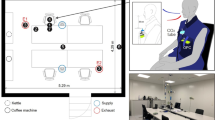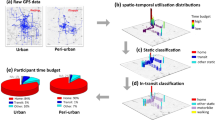Abstract
Daily exposure to PM2.5 in developing countries has not been thoroughly studied partly due to limited resources available. In this research, personal PM2.5 exposures in urban communities in Indonesia were examined using a low-cost sensor, AS-LUNG. Fifty subjects were recruited in both wet and dry seasons. Their personal PM2.5 concentrations, environmental temperature, and relative humidity were measured using corrected AS-LUNG Portable worn or placed in their vicinity. Details on their activities and locations, air quality (air pollution sources), and weather conditions during monitoring were recorded in time-activity diaries completed at 30 min intervals. Results revealed mosquito coil burning as the source of highest exposure, reaching 241.5 μg/m3 but with significant difference between wet and dry seasons. With ambient PM2.5 and relative humidity controlled for, mosquito coil burning contributed 12.02 μg/m3 and 4.84 μg/m3 of personal PM2.5 exposure in wet and dry season, respectively, which was several times higher than the contribution from vehicle emission. The second most contributive source was factory smoke, which increased 4.99 μg/m3 and 3.17 μg/m3 of exposure in wet and dry season, respectively. Findings on contributive factors of high daily personal exposures can serve as useful references for formulating policies and recommendations on exposure reduction and health protection.
This is a preview of subscription content, access via your institution
Access options
Subscribe to this journal
Receive 6 print issues and online access
$259.00 per year
only $43.17 per issue
Buy this article
- Purchase on Springer Link
- Instant access to full article PDF
Prices may be subject to local taxes which are calculated during checkout



Similar content being viewed by others
References
Pope III CA, Dockery DW. Health effects of fine particulate air pollution: lines that connect. J Air Waste Manag Assoc. 2006;56:709–42.
Madsen C, Rosland P, Hoff DA, Nystad W, Nafstad P, Næss ØE. The short-term effect of 24-h average and peak air pollution on mortality in Oslo, Norway. Eur J Epidemiol. 2012;27:717–27.
Janssen N, Fischer P, Marra M, Ameling C, Cassee F. Short-term effects of PM2.5, PM10 and PM2.5–10 on daily mortality in the Netherlands. Sci Total Environ. 2013;463-464:20–6.
World Health Organization (WHO). WHO releases country estimates on air pollution exposure and health impact. Geneva 2016. https://www.who.int/en/news-room/detail/27-09-2016-who-releases-country-estimates-on-air-pollution-exposure-and-health-impact. (Accessed date 10 May 2020).
Mazaheri M, Clifford S, Yeganeh B, Viana M, Rizza V, Flament R, et al. Investigations into factors affecting personal exposure to particles in urban microenvironments using low-cost sensors. Environ Int. 2018;120:496–504.
Lung SC, Hsiao PK, Wen TY, Liu CH, Fu CB, Cheng YT. Variability of intra-urban exposure to particulate matter and CO from Asian-type community pollution sources. Atmos Environ. 2014;83:6–13.
World Bank Group. The World Bank in Indonesia 2019. https://www.worldbank.org/en/country/indonesia. (Accessed date 14 May, 2020).
Sumaryati. Polusi udara di kawasan cekungan Bandung. Ber Dirgant. 2011;12:83–9.
Hsu WT, Chen JL, Lung SC, Chen YC. PM2.5 exposure of various microenvironments in a community: characteristics and applications. Environ Pollut. 2020;263:114522.
Lim S, Kim J, Kim T, Lee K, Yang W, Jun S, et al. Personal exposures to PM2.5 and their relationships with microenvironmental concentrations. Atmos Environ. 2012;47:407–12.
Li T, Cao S, Fan D, Zhang Y, Wang B, Zhao X, et al. Household concentrations and personal exposure of PM2.5 among urban residents using different cooking fuels. Sci Total Environ. 2016;548-549:6–12.
Patel D, Shibata T, Wilson J, Maidin A. Challenges in evaluating PM concentration levels, commuting exposure, and mask efficacy in reducing PM exposure in growing, urban communities in a developing country. Sci Total Environ. 2016;543:416–24.
Both AF, Westerdahl D, Fruin S, Haryanto B, Marshall JD. Exposure to carbon monoxide, fine particle mass, and ultrafine particle number in Jakarta, Indonesia: effect of commute mode. Sci Total Environ. 2013;443:965–72.
Lung SC, Chen N, Hwang JS, Hu SC, Wang WC, Wen TYJ, et al. Panel study using novel sensing devices to assess associations of PM2.5 with heart rate variability and exposure sources. Accepted by J Expo Sci Environ Epidemiol in special issue: Sensing for Exposure Science, in press.
Tang CS, Lung SC, Chang TY, Tu HH, Chang LT. Investigation of microenvironmental exposures to particle-bound polycyclic aromatic hydrocarbons for elementary school children. Int J Environ Res Public Health. 2019;16:4390.
Quinn C, Miller-Lionberg DD, Klunder KJ, Kwon J, Noth EM, Mehaffy J, et al. Personal exposure to PM2.5 black carbon and aerosol oxidative potential using an automated microenvironmental aerosol sampler (AMAS). Environ Sci Technol. 2018;52:11267–75.
Sayahi T, Kaufman D, Becnel T, Kaur K, Butterfield A, Collingwood S, et al. Development of a calibration chamber to evaluate the performance of low-cost particulate matter sensors. Environ Pollut. 2019;255:113131.
Lung SC, Wang WCV, Wen TYJ, Liu CH, Hu SC. A versatile low-cost sensing device for assessing PM2.5 spatiotemporal variation and quantifying source contribution. Sci Total Environ. 2020;716:137145.
Zhang LW, Chen X, Xue XD, Sun M, Han B, Li CP, et al. Long-term exposure to high particulate matter pollution and cardiovascular mortality: a 12-year cohort study in four cities in northern China. Environ Int. 2014;62:41–7.
Hoek G, Krishnan RM, Beelen R, Peters A, Ostro B, Brunekreef B, et al. Long-term air pollution exposure and cardio- respiratory mortality: a review. Environ Health 2013;12:43.
Enotoriuwa R, Nwachukwu E, Ugbebor J. Assessment of particulate matter concentration among land use types in Obigbo and environs in rivers state Nigeria. Int J Civ Eng Technol. 2016;7:252–61.
World Health Organization (WHO). WHO Air quality guidelines for particulate matter, ozone, nitrogen dioxide and sulfur dioxide: global update 2005: summary of risk assessment. Geneva: World Health Organization; 2006.
Urso P, Cattaneo A, Garramone G, Peruzzo C, Cavallo DM, Carrer P. Identification of particulate matter determinants in residential homes. Build Environ. 2015;86:61–9.
Hernandez W, Mendez A, Zalakeviciute R, Diaz-Marquez AM. Analysis of the information obtained from PM2.5 concentration measurements in an urban park. IEEE Trans Instrum Meas. 2020.
Liu W, Zhang J, Hashim JH, Jalaludin J, Hashim Z, Goldstein BD. Mosquito coil emissions and health implications. Environ Health Perspect. 2003;111:1454–60.
Chen SC, Wong RH, Shiu LJ, Chiou MC, Lee H. Exposure to mosquito coil smoke may be a risk factor for lung cancer in Taiwan. J Epidemiol. 2008;18:19–25.
Wang L, Zheng X, Stevanovic S, Xiang Z, Liu J, Shi H, et al. Characterizing pollutant emissions from mosquito repellents incenses and implications in risk assessment of human health. Chemosphere 2018;191:962–70.
Massey D, Masih J, Kulshrestha A, Habil M, Taneja A. Indoor/outdoor relationship of fine particles less than 2.5μm (PM2.5) in residential homes locations in central Indian region. Build Environ. 2009;44:2037–45.
Susanna D. Weather Implication for Dengue Fever in Jakarta, Indonesia 2008-2016. KnE Life Sciences. 2018:184–92.
Rivas I, Kumar P, Hagen-Zanker A, Andrade MdF, Slovic AD, Pritchard JP, et al. Determinants of black carbon, particle mass and number concentrations in London transport microenvironments. Atmos Environ. 2017;161:247–62.
Kaur S, Nieuwenhuijsen M. Determinants of personal exposure to PM2.5, ultrafine particle counts, and CO in a transport microenvironment. Environ Sci Technol. 2009;43:4737–43.
Nyhan M, McNabola A, Misstear B. Comparison of particulate matter dose and acute heart rate variability response in cyclists, pedestrians, bus and train passengers. Sci Total Environ. 2014;468:821–31.
Fischer F, Kraemer A. Health impact assessment for second-hand smoke exposure in Germany—quantifying estimates for ischaemic heart diseases, COPD, and stroke. Int J Environ Res Public Health. 2016;13:198.
Lee CH, Yang SF, Peng CY, Li RN, Chen YC, Chan TF, et al. The precancerous effect of emitted cooking oil fumes on precursor lesions of cervical cancer. Int J Cancer. 2010;127:932–41.
Wu SC, Yen GC. Effects of cooking oil fumes on the genotoxicity and oxidative stress in human lung carcinoma (A-549) cells. Toxicol Vitr. 2004;18:571–80.
Chang LW, Lo WS, Lin P. Trans, trans-2,4-decadienal, a product found in cooking oil fumes, induces cell proliferation and cytokine production due to reactive oxygen species in human bronchial epithelial cells. Toxicol Sci. 2005;87:337–43.
Acknowledgements
This work was partially funded by the International Council for Science Regional Office for Asia and the Pacific (ICSU ROAP) and Integrated Research on Disaster Risk and the International Centre of Excellence Taipei (IRDR ICoE-Taipei) under the Seed Grant Program, and by the Research Center for Environmental Changes, Academia Sinica, Taiwan under grant no. AS-SS-107–03. The authors gratefully acknowledge supports from all study participants and the insightful discussion with Professors Eddy Himawan and Puji Lestari, Dr Nur Faizah, and Ir. Emalya Rachmawati. We also thank Ir. Halimurrahman, MT, Director of The Center for Atmospheric Science and Technology, National Institute of Aeronautics and Space (LAPAN), Bandung for endorsing our collaboration with his research group.
Author information
Authors and Affiliations
Corresponding author
Ethics declarations
Conflict of interest
The authors declare that they have no conflict of interest.
Additional information
Publisher’s note Springer Nature remains neutral with regard to jurisdictional claims in published maps and institutional affiliations.
Supplementary information
Rights and permissions
About this article
Cite this article
Sinaga, D., Setyawati, W., Cheng, F.Y. et al. Investigation on daily exposure to PM2.5 in Bandung city, Indonesia using low-cost sensor. J Expo Sci Environ Epidemiol 30, 1001–1012 (2020). https://doi.org/10.1038/s41370-020-0256-9
Received:
Revised:
Accepted:
Published:
Issue Date:
DOI: https://doi.org/10.1038/s41370-020-0256-9
Keywords
This article is cited by
-
Quantification of Fine Particulate Matter (PM2.5) and Its Correlation with Meteorological Parameters Within the Ambient Air of Automobile Workshops in Benin City
Aerosol Science and Engineering (2023)
-
Recent advancements in low-cost portable sensors for urban and indoor air quality monitoring
Air Quality, Atmosphere & Health (2021)



